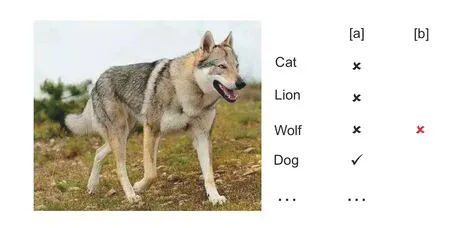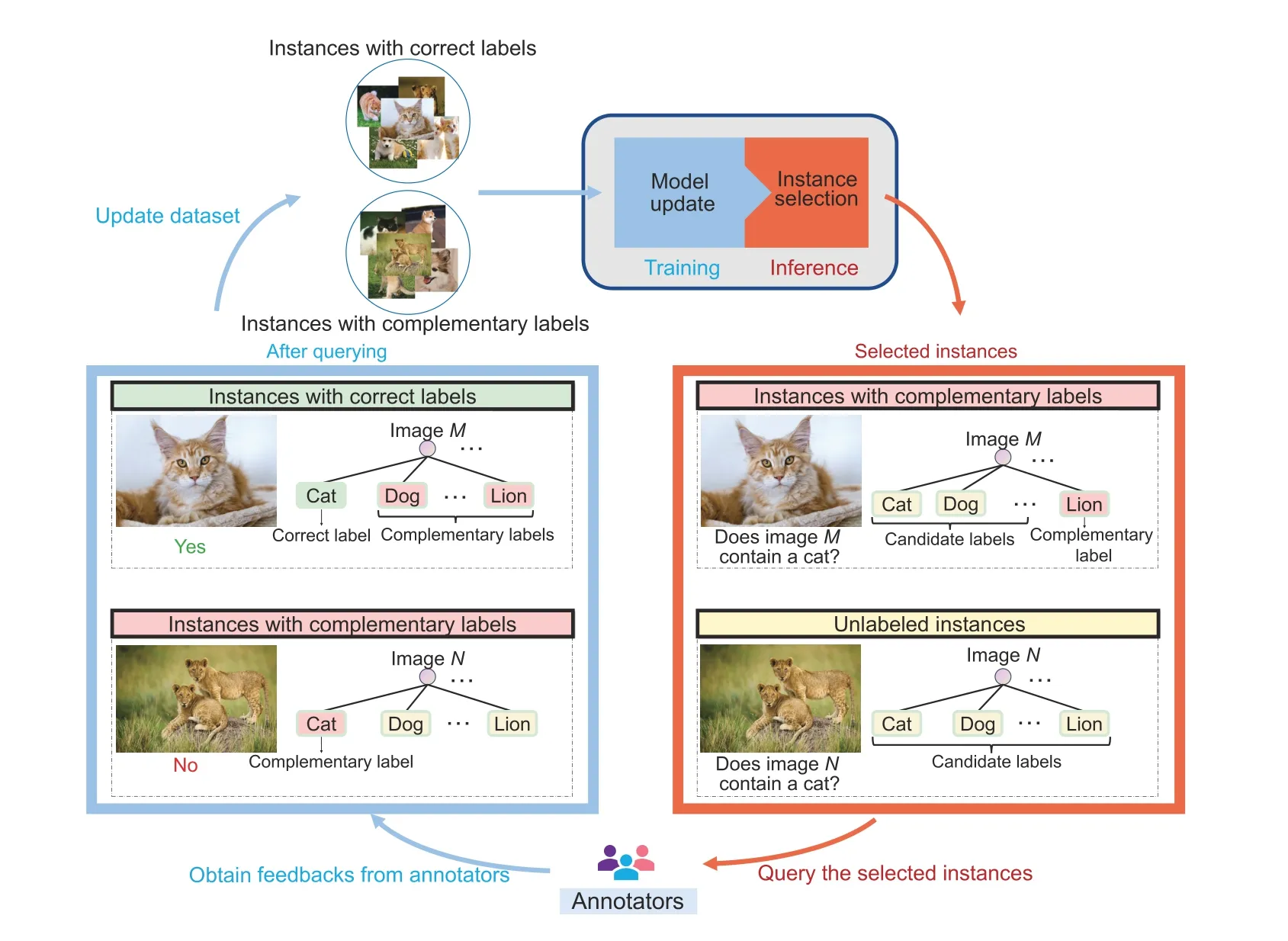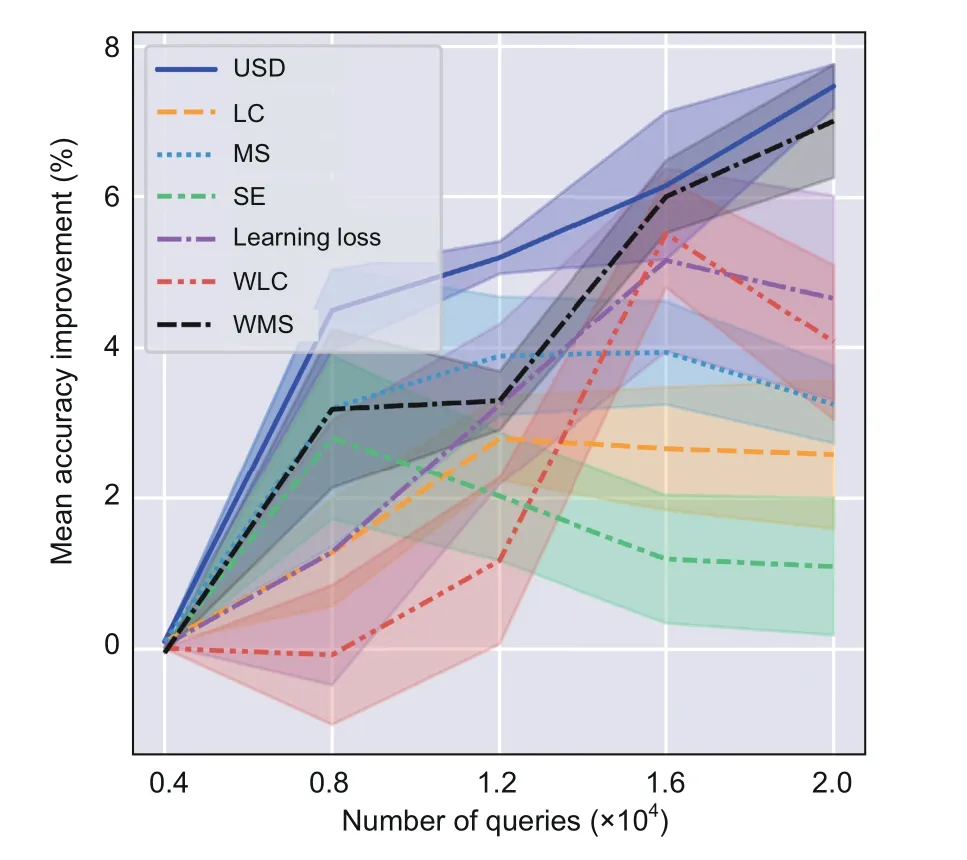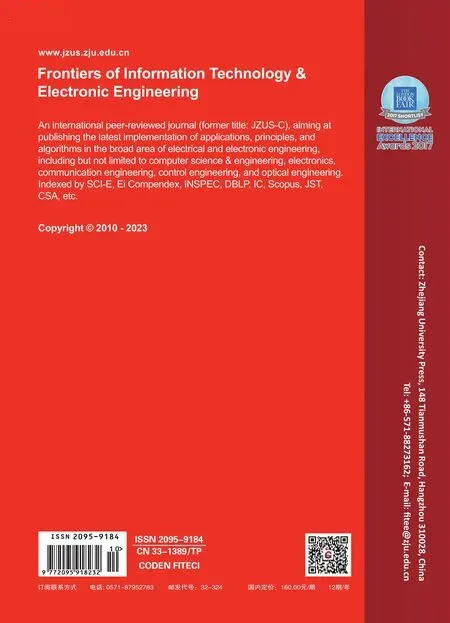Correspondence:Uncertainty-aware complementary label queries for active learning∗
Shengyuan LIU ,Ke CHEN ,Tianlei HU ,Yunqing MAO
1Key Lab of Intelligent Computing Based Big Data of Zhejiang Province,Zhejiang University,Hangzhou 310027,China
2State Key Laboratory of Blockchain and Data Security,Zhejiang University,Hangzhou 310027,China
3City Cloud Technology (China) Co.,Ltd.,Hangzhou 310000,China
Many active learning methods assume that a learner can simply ask for the full annotations of some training data from annotators.These methods mainly try to cut the annotation costs by minimizing the number of annotation actions.Unfortunately,annotating instances exactly in many realworld classification tasks is still expensive.To reduce the cost of a single annotation action,we try to tackle a novel active learning setting,named active learning with complementary labels (ALCL).ALCL learners ask only yes/no questions in some classes.After receiving answers from annotators,ALCL learners obtain a few supervised instances and more training instances with complementary labels,which specify only one of the classes to which the pattern does not belong.There are two challenging issues in ALCL:one is how to sample instances to be queried,and the other is how to learn from these complementary labels and ordinary accurate labels.For the first issue,we propose an uncertainty-based sampling strategy under this novel setup.For the second issue,we upgrade a previous ALCL method to fit our sampling strategy.Experimental results on various datasets demonstrate the superiority of our approaches.
1 Introduction
Traditional multi-class classification methods typically necessitate fully-annotated data,a process which can be time-consuming and costly.To mitigate the extensive resource allocation for annotation actions,researchers have explored various ways to learn from weakly supervised annotations (Zhou,2018): active learning (AL) (Sinha et al.,2019;Yoo and Kweon,2019),semi-supervised learning (Zhang T and Zhou,2018),partial label learning (Wang et al.,2019),and others.Among these,AL assumes that different samples in the same dataset have different values for the update of the current model,and tries to select the samples with the highest value from the training set.In this paper,we explore AL and another weakly supervised learning framework named complementary-label learning (Ishida et al.,2017,2019),as shown in Fig.1.

Fig.1 Example of an image with full annotation [a]and complementary label [b].In the complementarylabel setting,we know only that this image does not contain a wolf
Many classic AL methods assume that the ground-truth labels of unlabeled samples can be obtained from an oracle (Ren et al.,2021).The primary objective of these methods is to indirectly cut the annotation costs by minimizing the number of required label queries (Settles,2011).However,in several practical scenarios,acquiring full annotations for patterns from an oracle remains costly,such as for multi-class classification tasks.Consequently,it raises the question: is it feasible to directly decrease the total annotation costs by reducing the expense associated with a single annotation action?
To tackle this problem,a few active learning approaches have provided some practicable ways to reduce the annotation costs.For example,ALPF (Hu et al.,2019) learners engage in querying semantic information and acquire partial feedback from annotators.Nonetheless,ALPF needs additional prior knowledge to generate semantic questions,and post-pruning exists in the sampling process.WEAKAL (Gonsior et al.,2020) uses typical AL techniques,and uses the outputs of a network as additional weak labels.Nevertheless,when the instances are difficult to annotate,this algorithm is error-prone due to the low quality of weak labels.Zhang CC and Chaudhuri (2015) used both strong and weak labelers to save the limited budget.Duo-Lab (Younesian et al.,2020) uses a similar method in online active learning.However,these two algorithms still need strong labelers.Inspired by ALPF,we want to obtain weak annotation only from weak labelers without extra prior knowledge.Thus,we try to combine AL with complementary-label learning.
In summary,we tackle a novel ALCL(Liu et al.,2023),as shown in Fig.2.There are two challenging issues in ALCL: the first is how to learn from complementary and ordinary labels,and the second is how to sample instances to be queried (Liu et al.,2023).To solve the first issue,we upgrade the method named weight redistribution based on the balance of category contribution from Liu et al.(2023),which treated the candidate and complementary labels differently.This approach incorporates instance-wise reweighting into the loss function to concern candidate labels,thereby emphasizing instances with a reduced number of candidate labels.For the second issue,we design a new sampling strategy named uncertainty for sampling and deep learning (USD) based on the strength of ALCL and uncertainty in deep learning.Comprehensive experimental results illustrate that this revised weight redistribution based on the balance of category contribution (WEBB) method outperforms state-of-theart complementary-label learning algorithms.Furthermore,our USD sampling strategy has indeed been improved upon existing sampling strategies in ALCL.

Fig.2 Workflow for an ALCL learner (ALCL: active learning with complementary labels)
2 Preliminaries
Our work expands upon the AL framework(Settles,2009),complementary-label learning (Ishida et al.,2017),and ALCL (Liu et al.,2023),and our proposed USD sampling strategy is based on the uncertainty in deep learning.In this section,we briefly review the uncertainty in deep learning.
There are two main kinds of uncertainty for deep neural networks: epistemic uncertainty and aleatoric uncertainty.Epistemic uncertainty accounts for uncertainty in the model parameters and can be improved with enough data,so it is often referred to as model uncertainty.Aleatoric uncertainty can be further categorized as homoscedastic uncertainty and heteroscedastic uncertainty.Homoscedastic uncertainty remains constant for different inputs,whereas heteroscedastic uncertainty depends on the input samples of the model.For example,some inputs could be more challenging to recognize in image recognition.A model usually has high heteroscedastic uncertainty on inputs with low confidence.
Recently,many researchers have investigated how to estimate and use uncertainty in deep learning(Blundell et al.,2015;Gal and Ghahramani,2016).With these techniques,uncertainty-based methods are introduced into multi-view learning(Geng et al.,2021),few-shot classification(Zhang ZZ et al.,2020),and multi-task learning (Cipolla et al.,2018).Geng et al.(2021) assumed that inputs are sampled from different Gaussian distributions,and that the variance in Gaussian distributions reflects the uncertainty of inputs.Zhang ZZ et al.(2020)characterized the uncertainty by the variance between inputs and prototypes.Cipolla et al.(2018) used Boltzmann distribution to build the relationship between inputs and prediction,and the conditional probability to handle different tasks.Arnab et al.(2020) introduced uncertainty to weigh the samples with weak annotations in action recognition.Inspired by these studies,our method attempts to use the uncertainty in deep learning to guide the queries of active learning.In other words,the uncertainty in our approach has a dual purpose,deciding which sample to query and guiding how to learn from samples.
3 The proposed framework
In this section,we first introduce two reasonable sampling strategies as baselines.Then,we introduce our USD strategy.Finally,we upgrade the previous ALCL method WEBB.
3.1 Baselines
In the ALCL problem,the number of complementary labels should be considered in sampling strategies.We use a weighting mechanism in Eq.(1)that considers this particularity:
wherep(m|xi) represents the conventional confidence level associated with instancexifor labelm,andis the complementary label set.The hyperparameterαsignifies a preference factor,and whenα >0,it indicates a proclivity towards selecting instances exhibiting a smaller number of complementary labels.
In our previous study (Liu et al.,2023),we have applied this weighting scheme on two conventional uncertainty-based sampling strategies: leastconfidence(LC) (Culotta and McCallum,2005)and margin sampling (MS) (Scheffer et al.,2001).From these,two baselines have been established: weighted least-confidence (WLC) and weighted margin sampling(WMS) (Liu et al.,2023).
3.2 Uncertainty for sampling and deep learning
In AL,many uncertainty-based methods use various types of data uncertainty to decide which sample to query.Although they indeed obtain valuable samples to query,they usually ignore the possible usage of uncertainty in deep learning.Inspired by these,we use one kind of uncertainty to decide which sample to query and guide how to learn from samples.
Our primary purpose is,for the network,to learn from samples with low uncertainty or generate high uncertainty and avoid being penalized heavily for noisy samples where the information is insuffi-cient.The samples with high uncertainty will be queried later.With the original loss,we define our uncertainty loss as
whereL(x,y) is the original loss function andσ2(x)is the uncertainty ofx.WhenL(x,y) is cross entropy,this corresponds to assuming a Boltzmann distribution on the output of the network with a temperature ofσ2,and approximately minimizing its log-likelihood (Cipolla et al.,2018).Forσ,we use an uncertainty prediction module to additionally predict the uncertaintyσ2(x) for samples.The number of complementary labels will influence the uncertainty.
In fact,we use the uncertainty prediction module to directly predictv:=logσ2and obtain=exp(-v) in the following experiments.Because if we predictσorσ2,dividing by 0 may happen when computing.
3.3 WEBB with USD
From Section 3.2,we know that different inputs have different uncertainties in USD,so we cannot obtain lossLufrom candidate label classification loss in WEBB (Liu et al.,2023).When we use USD as the sampling strategy,candidate label classification loss will be written as
wherewikis the weight of instanceiwith lablek,nis the size of the dataset,andKis the number of labels.
Then we can calculate the final training loss with complementary-label classification loss.
4 Experiments
4.1 Experimental setup
1.Datasets and optimization.We use four widely-used benchmark datasets: MNIST (LeCun et al.,1998),Fashion-MNIST (Xiao et al.,2017),Kuzushiji-MNIST (Clanuwat et al.,2018),and CIFAR-10(Krizhevsky and Hinton,2009).
In subsequent experiments,the allocated query limit for each dataset is 20 000.For datasets MNIST,Fashion-MNIST,and Kuzushiji-MNIST,a multilayer perceptron(MLP)model(d-500-k)is trained as the primary framework,while ResNet(18 layers)(He et al.,2016)is used in CIFAR-10.
The optimization process is conducted with Adam(Kingma and Ba,2015),applying a weight decay of 1×10-4on weight parameters.Learning rates for each dataset are evaluated from {1×10-5,5×10-5,1×10-4,5×10-4,1×10-3},and reduced by half every 50 epochs.The suggested learning rates are selected by the performance on a validation subset extracted from the training dataset.
2.Baselines and the proposed method.The effi-cacy of the updated WEBB is evaluated in contrast with two complementary-label learning algorithms,LOG and EXP (Feng et al.,2020).Each of them is parameterized using experimental results acquired from a validation dataset.
For the sampling strategies,we assess the performance of our approach USD in contrast to random sampling,LC (Culotta and McCallum,2005),MS(Scheffer et al.,2001),WLC,WMS,sequence entropy(SE)(Settles and Craven,2008),and the learning loss strategy (Yoo and Kweon,2019).In the SE approach,the candidate labels are taken into consideration collectively for entropy calculation.The learning loss strategy introduces an additional auxiliary module,named the loss prediction module,with the purpose of predicting the loss associated with the target model.This auxiliary module is employed to identify challenging instances for the target model.In the following experiments,the variableαis set to 0.1 for both WLC and WMS.The hidden dimension of the loss prediction module in learning loss is kept at 128 as recommended.
4.2 Comparison among complementary-label learning approaches
We record the comprehensive mean and standard deviation of the test accuracy after every training epoch.In Fig.3,the mean and standard deviation of test accuracy for LOG,EXP,and our revised WEBB are depicted during the last 250 training epochs.

Fig.3 Experimental results across diverse datasets and models with varied sampling strategies: (a)CIFAR-10;(b) MNIST;(c) Fashion-MNIST;(d) Kuzushiji-MNIST.Dark colors represent the average accuracy derived from the five trials,while light colors denote the corresponding standard deviation
Fig.3 shows that the performance of EXP is inconsistent due to its nearly equal treatment of instances with varying numbers of complementary labels as mentioned previously.Equipped with each sampling strategy,the refined WEBB and LOG work well in ALCL,and the refined WEBB outperforms all other methods on various datasets.
4.3 Comparison among active sampling strategies
Fig.4 presents the mean and standard deviation of accuracy enhancement compared to the random sampling baseline(based on five trials)over the number of queries on CIFAR-10.The random sampling baseline means that the model is trained to converge with data from previous queries,and the sampling of data is random.The improvements of the other methods over the random sampling baseline reflect the quality of sampling under the same number of queries.

Fig.4 Mean accuracy enhancements with standard deviation(denoted by shading)of active learning methods compared to the random sampling baseline,across the number of queries on CIFAR-10.Dark colors represent the mean accuracy of the five trials,while light colors indicate the standard deviation.The loss function used in these trials is from WEBB
Fig.4 shows that USD outperforms the other sampling strategies substantially,especially in the early stages,because the uncertainty in USD does not significantly depend on the accuracy of the current network.Specifically,USD uses an uncertainty prediction module to guide the sampling of instances.The training of the uncertainty prediction module is easier than the training of the original network,so we can obtain more valuable instances in the early stages with USD.
5 Conclusions
In this paper,we tackle the problem of ALCL (Liu et al.,2023).The objective of ALCL is to directly reduce the cost of annotation actions in AL,while providing a feasible approach for obtaining complementary labels.To solve ALCL,we design a sampling strategy USD,which uses the uncertainty in deep learning to guide the queries of active learning in this novel setup.Moreover,we upgrade the WEBB method to suit this sampling strategy.Comprehensive experimental results validate the performance of our proposed approaches.In the future,we plan to investigate the applicability of our approaches to large-scale datasets and account for noise in the feedback of annotators.
Contributors
Shengyuan LIU designed the research,processed the data,and drafted the paper.Yunqing MAO helped organize the paper.Ke CHEN and Tianlei HU revised and finalized the paper.
Compliance with ethics guidelines
Shengyuan LIU,Ke CHEN,Tianlei HU,and Yunqing MAO declare that they have no conflict of interest.
Data availability
The data that support the findings of this study are available from the corresponding author upon reasonable request.
 Frontiers of Information Technology & Electronic Engineering2023年10期
Frontiers of Information Technology & Electronic Engineering2023年10期
- Frontiers of Information Technology & Electronic Engineering的其它文章
- Correspondence:A low-profile dual-polarization programmable dual-beam scanning antenna array*#
- Path guided motion synthesis for Drosophila larvae*#
- Wideband and high-gain BeiDou antenna with a sequential feed network for satellite tracking
- Synchronization transition of a modular neural network containing subnetworks of different scales*#
- RFPose-OT:RF-based 3D human pose estimation via optimal transport theory∗
- Attention-based efficient robot grasp detection network∗
